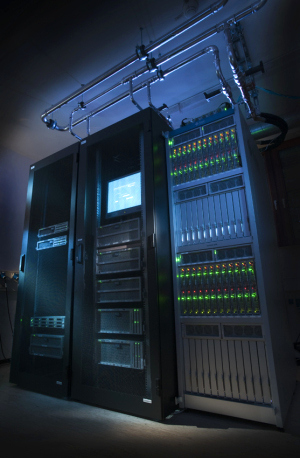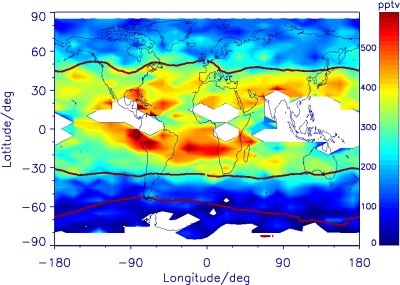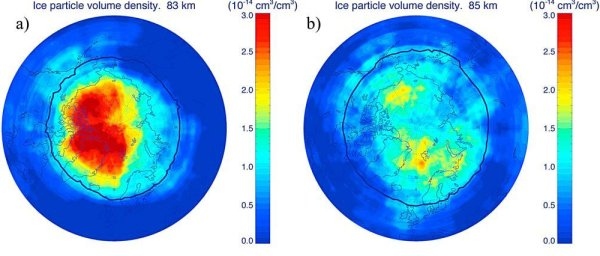Die Deutsche Physikalische Gesellschaft (DPG) und die Société Française de Physique (SFP) zeichnen den Klimaforscher für seine Beiträge zur Vermessung atmosphärischer Spurengase aus.
Für besonders wertvolle wissenschaftliche Leistungen in der Physik verleihen die DPG und die SFP jährlich gemeinsam den Gentner-Kastler-Preis. Zum Preisträger des Jahres 2017 wurde Johannes Orphal benannt „für seine herausragenden Beiträge zur Vermessung atmosphärischer Spurengase mit Hilfe hochauflösender Spektroskopie und für sein anhaltendes Engagement in der Europäischen und insbesondere der deutsch-französischen Zusammenarbeit auf dem Gebiet der Umweltphysik“. Die Preisverleihung findet anlässlich des Jahreskongresses der SFP im Sommer 2017 in Frankreich statt.
DPG
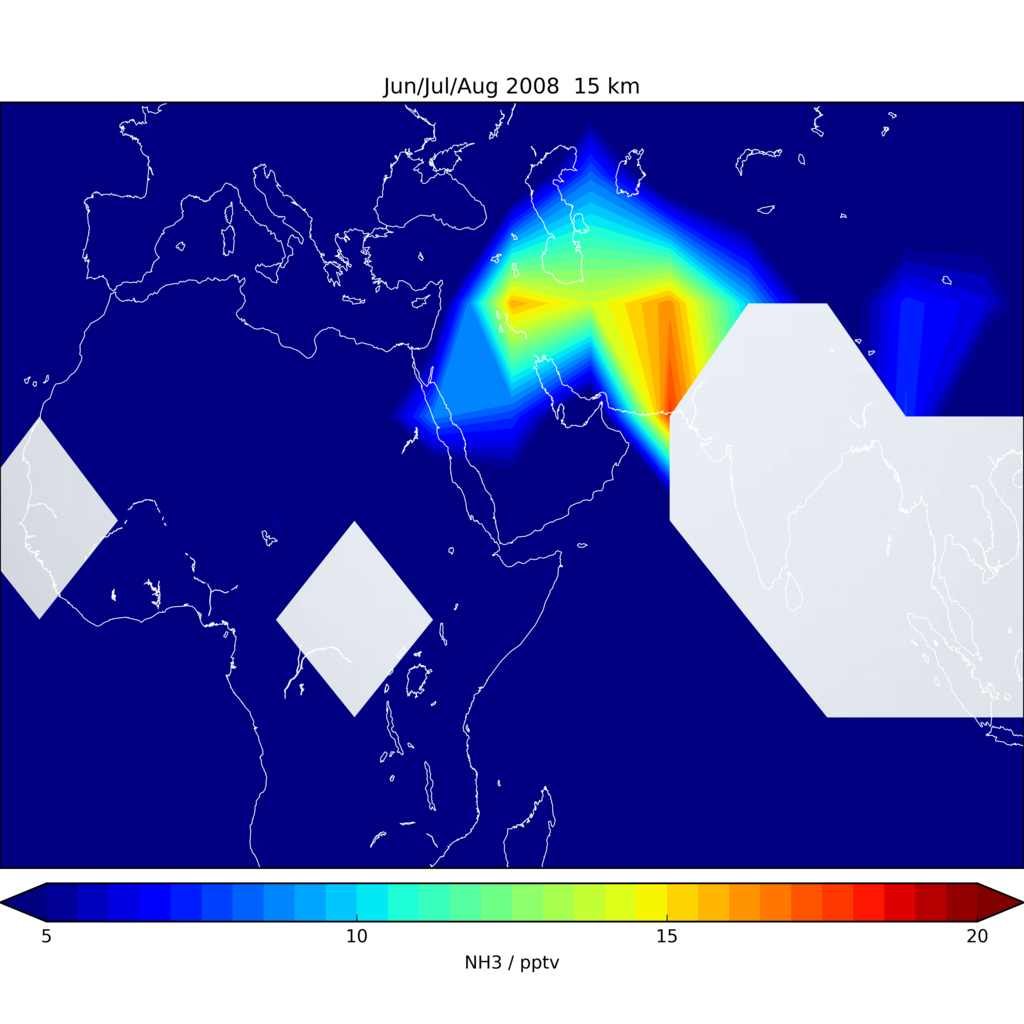
Ammonia (NH3) is important because of its influence on aerosol and cloud formation and its increasing anthropogenic emissions. By analysis of infrared limb emission spectra measured by the MIPAS instrument, NH3 has been detected in the upper troposphere for the first time. We have found enhanced values of NH3 within the Asian summer Monsoon upper troposphere where it might contribute to the composition of the Asian Tropopause Aerosol Layer.
With a new professorship in Geophysical Remote Sensing, the IMK-ASF is expanding its research and teaching activities, together with the Institute of Photogrammetry and Remote Sensing (IPF).
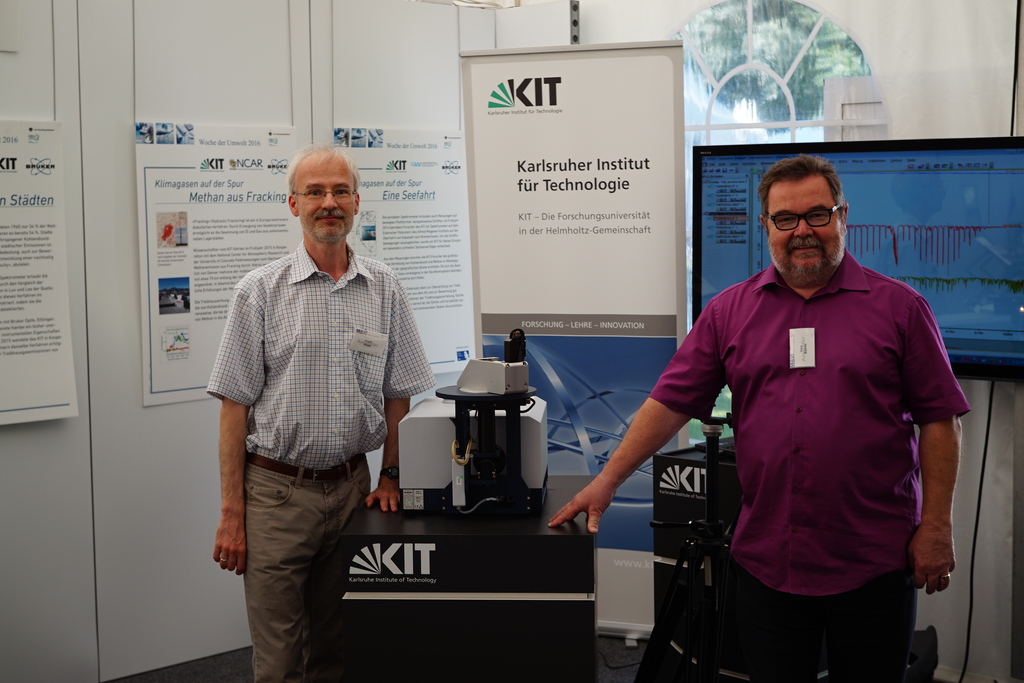
IMK-ASF Scientists have developed a mobile device for trace gas measurements, which can be used to determine local emission of trace gases. The small portable fourier spectrometer has so far been tested in various field campaigns, measuring emission from big cities such as Berlin, Paris or Tokio, the ocean, fracking or volcanoes. The spectrometer, developed in cooperation with Bruker Optik GmbH, was presented during the “week of the Environment” at Schloss Belvue, Berlin.
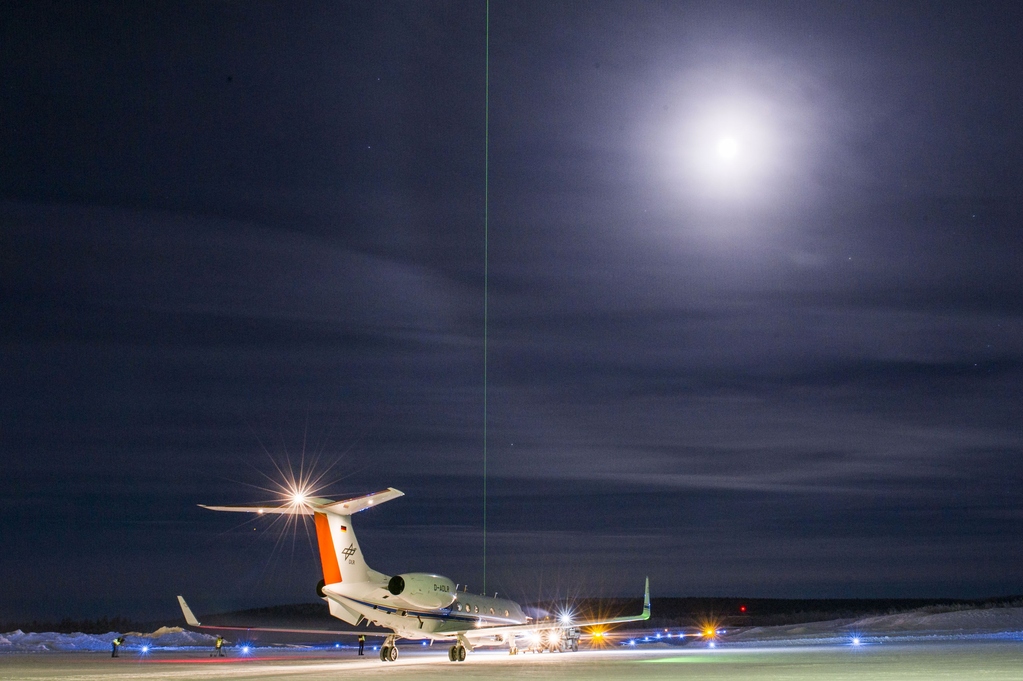
So far, the Arctic stratosphere has been unusually cold this winter setting the stage for strong ozone depletion over the coming few weeks. One important role are vertically expanded stratospheric clouds that have reached unusually low into the lower stratosphere and covered a broad area over the Arctic region. First signs of activation of chlorine and redistribution of reactive nitrogen and have been observed.
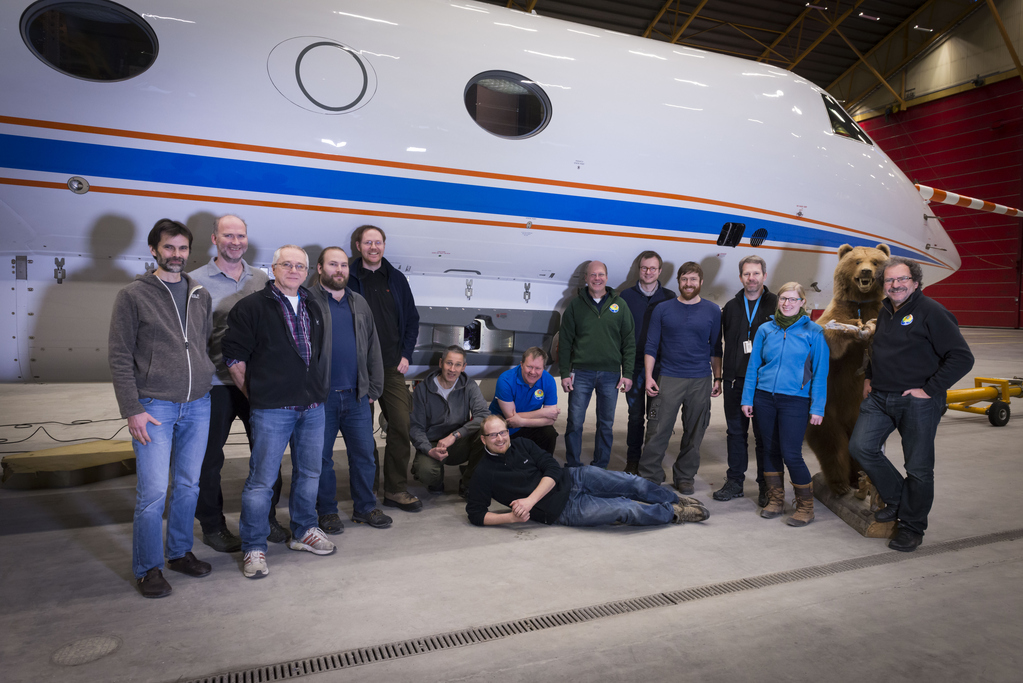
The KIT-coordinated measurement campaign POLSTRACC (Polar Stratosphere in a Changing Climate) studies impacts of climate change on the Arctic ozone layer and processes in the tropopause region below.
Currently, first test flights are carried out from the DLR base at Oberpfaffenhofen near Munich. Between January and March 2016, the “Arena Arctica” in Kiruna, Sweden, near the polar circle, will form the base for 10 to 15 research flights across the polar sea towards Greenland and the North Pole.
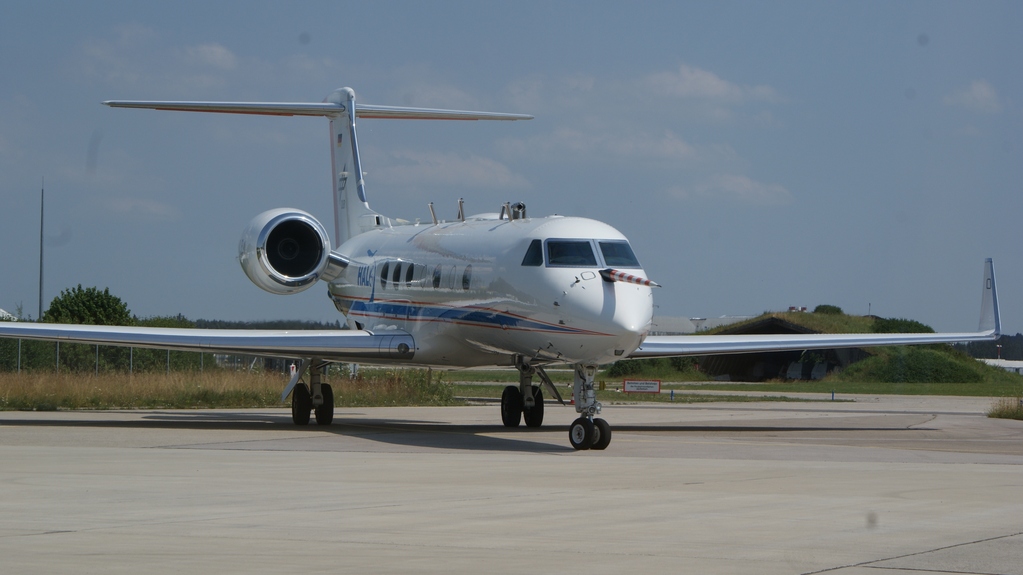
Die Selbstreinigungskraft der Atmosphäre steht im Fokus der 30-tägigen Halo Kampagne OMO (kurz für Oxidation Mechanism Observations, „Beobachtung von Mechanismen der Oxidation“), die am 21. Juli von Zypern aus gestartet ist. Zunächst stehen Analysen über der arabischen Halbinsel und dem arabischen Meer auf dem Programm. Dann wechseln Flugzeug, Crew und Team auf die Malediven, um von dort aus die Atmosphäre über dem indischen Ozean und dem Golf von Bengalen zu analysieren. Anschließend geht es nochmals zwei Wochen nach Zypern.

The MIPAS-B and TELIS balloon measurements obtained in northern Sweden on 31 March 2011 inside the stratospheric polar vortex have provided vertical profiles of inorganic and organic chlorine species as well as diurnal variations of ClO around sunrise over the whole altitude range in which chlorine has been undergoing activation and deactivation. The complete inorganic and organic chlorine partitioning and budget (representative for the late winter Arctic stratosphere) has been derived by combining MIPAS-B and TELIS simultaneously observed molecules. A total chlorine amount of 3.41 ± 0.30 ppbv is inferred from the measurements (between 25 and 36 km). This value is in line with previous stratospheric observations carried out outside the tropics confirming the slightly decreasing chlorine amount in the stratosphere
Read article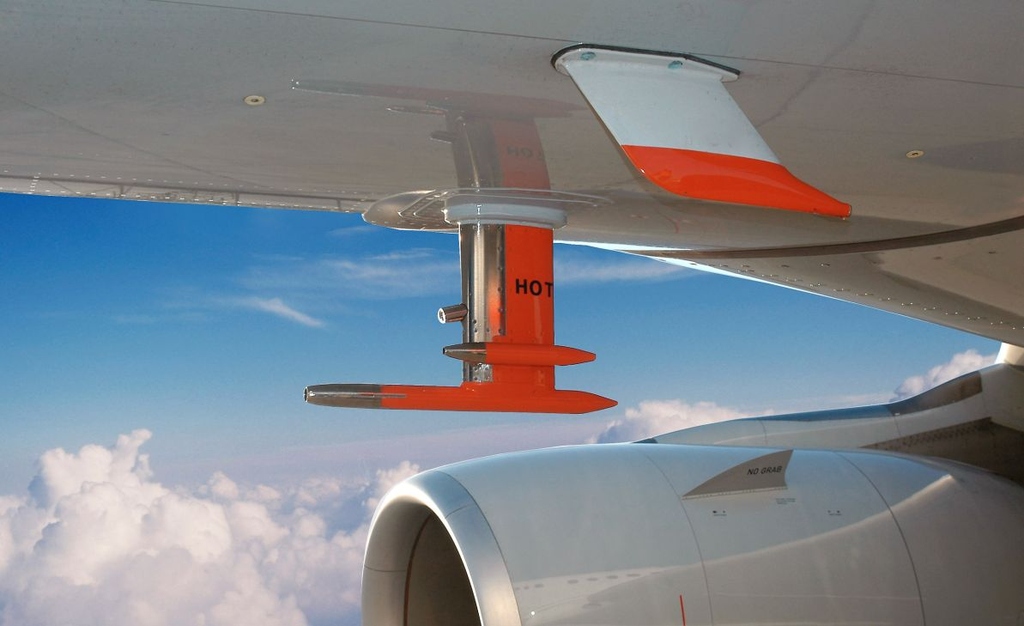
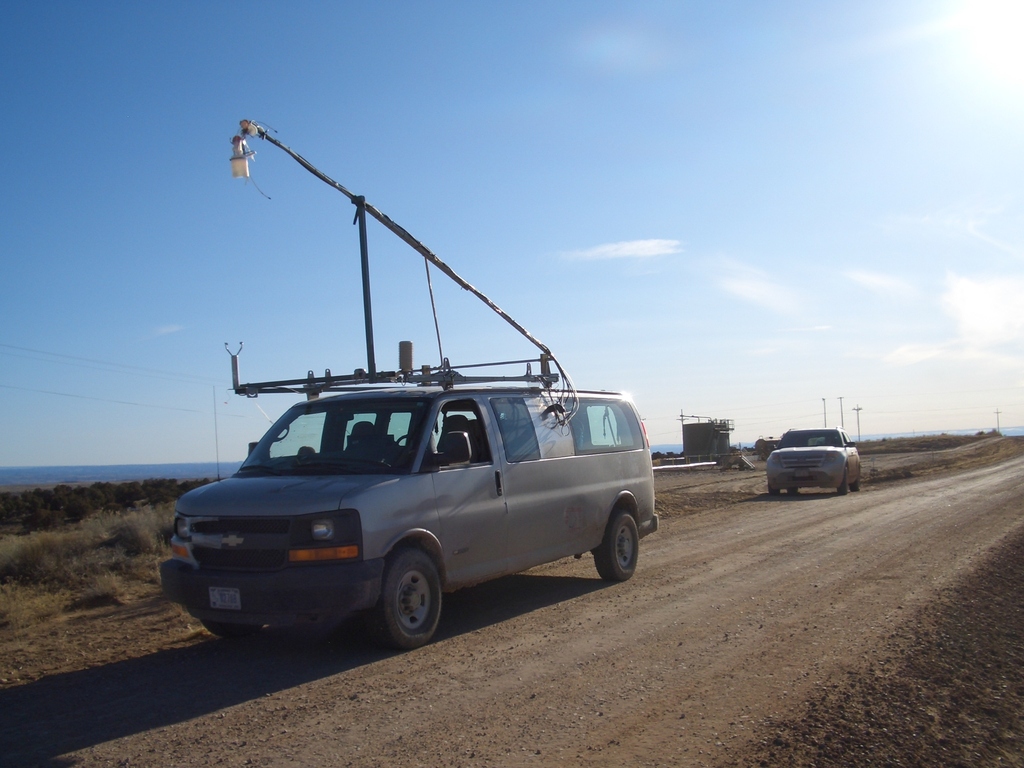
Emissions of volatile organic compounds (VOCs) associated with oil and
natural gas production in the Uintah Basin, Utah were measured with great
detail from a mobile laboratory using PTR-MS instruments. One of the
instruments was developed at ASF.
Read article
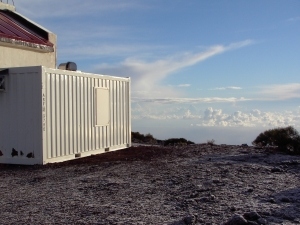
HCl is an indicator of ozone destroying substances in the stratosphere. In a recently published Nature paper, ASF-Scientists together with international colleagues, found a recent increase of HCl but could show that a change of the stratospheric circulation is responsible.
to the press release
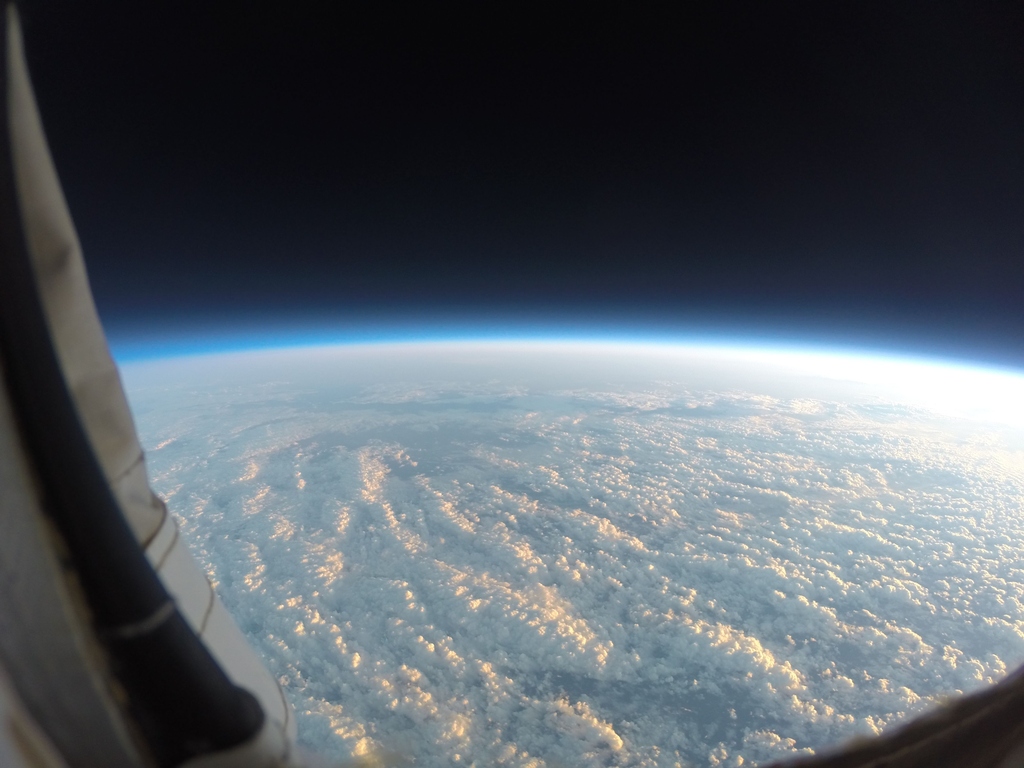
How much does bromine affect stratospheric ozone? Answering this question has been the primary objective of measurements by a multi-instrument gondola carried by a high-altitude balloon on 7-8 September 2014. The gondola accommodates a unique combination of remote sensing instruments coordinated by IMK-ASF of the Karlsruhe Institute of Technology (KIT) in cooperation with the German Aerospace Center (DLR) and the University of Heidelberg.
to the press release
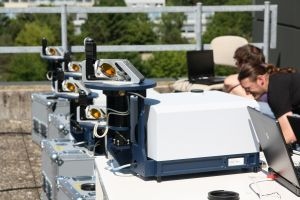
Eine neue Methode, um den Treibhausgasausstoß von Großstädten und anderen räumlich begrenzten Quellen zu messen, haben Wissenschaftler des Karlsruher Instituts für Technologie (KIT) entwickelt.
to the press release
Scientists from KIT measure atmospheric carbon dioxide and methane
concentrations from aboard the research vessel Polarstern.

Beitrag von Prof. Dr. Johannes Orphal in der Zeitschrift "Karlsruher Transfer".
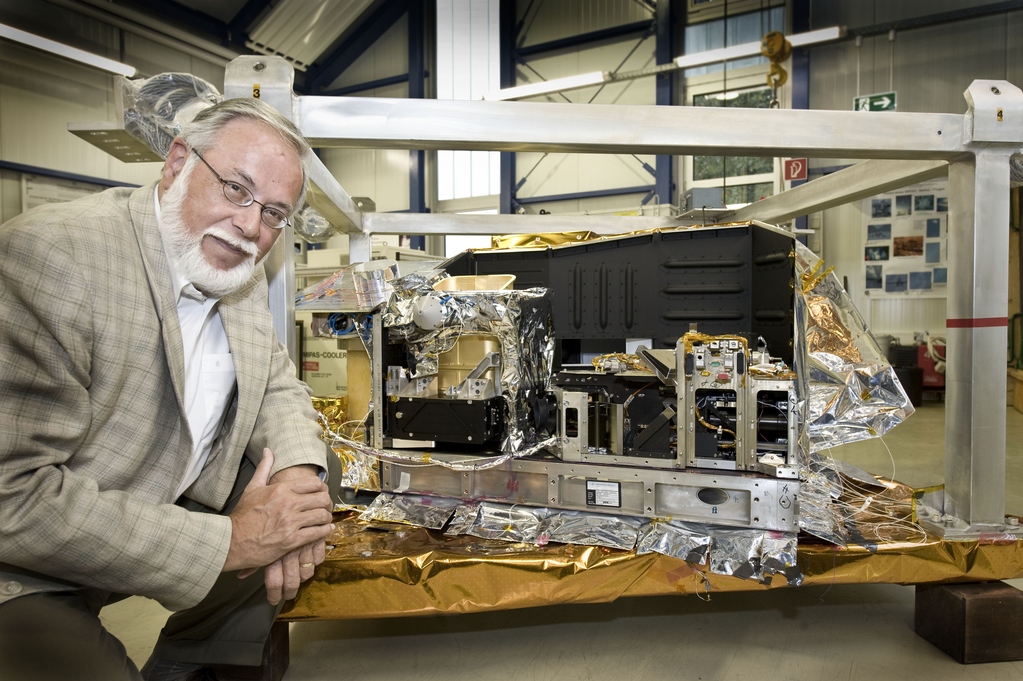
Für seine wegweisenden Arbeiten in der Atmosphärenforschung erhält Professor Herbert Fischer den Johannes-Georgi-Preis 2013. Der Preis gilt als höchste deutsche Auszeichnung in den Geowissenschaften.
Zur Pressemitteilung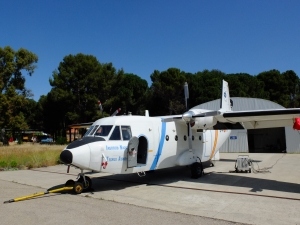
KIT Climate Researchers Prove Precision of Remote Sounding Measurements – MUSICA Project Focuses on Weather- and Climate-relevant Processes in the Atmosphere.
To the press release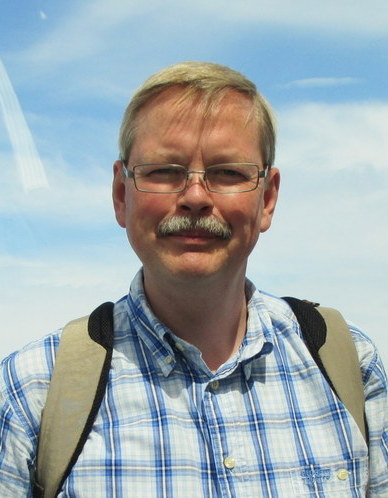
The IMK-ASF is strengthening its research and teaching portfolio through a new professorship in Atmospheric Physics
more...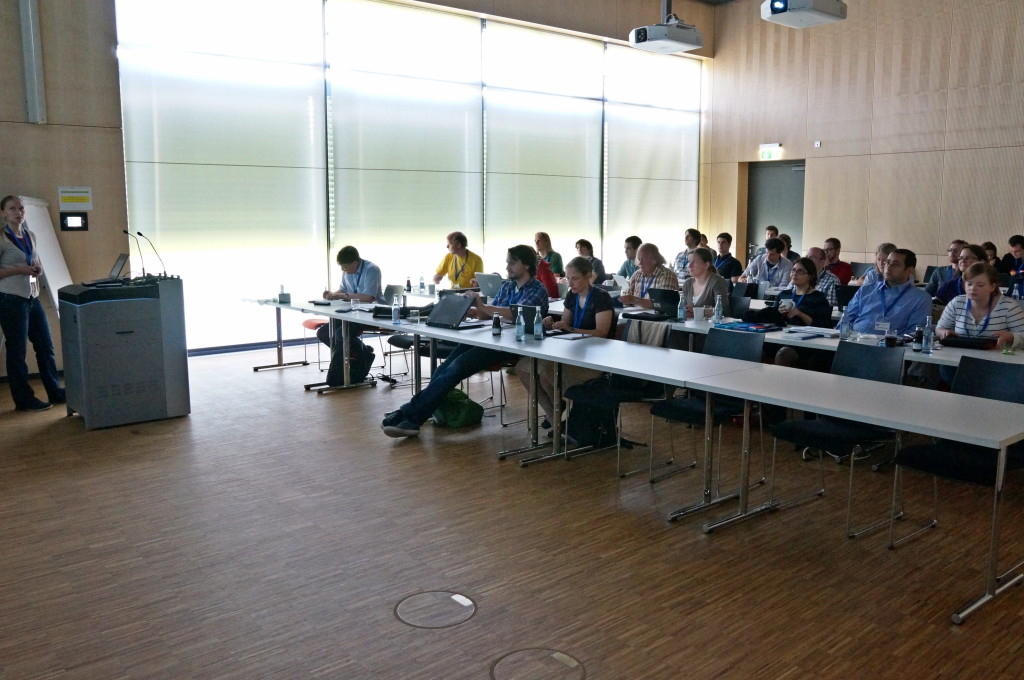
From 12th to 14th of June 50 scientists from 9 institutions discussed about the most recent findings in chemistry-climate modelling with the model system EMAC.
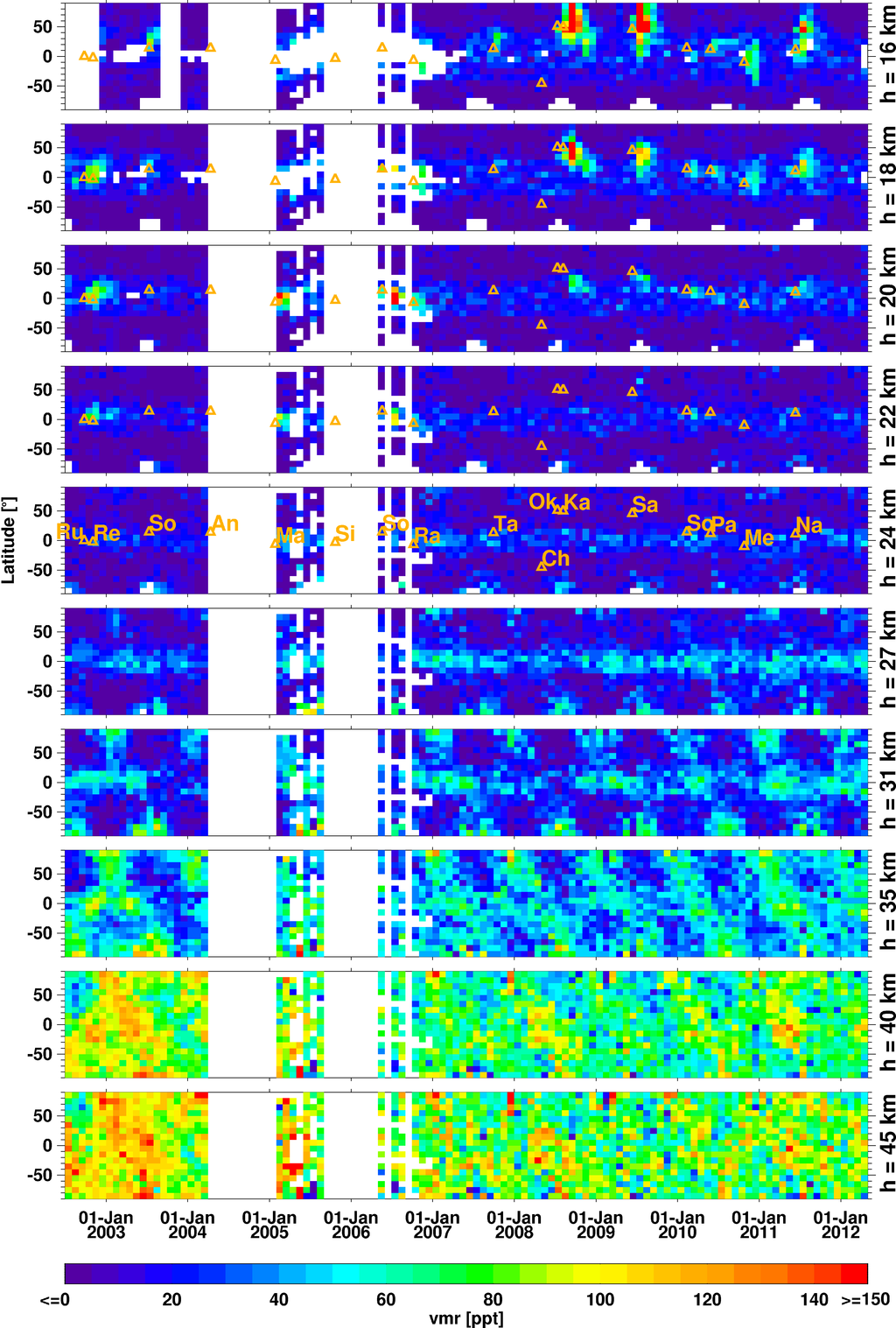
Erstmals umfassendes Bild der Schwefeldioxidbelastung in der Stratosphäre/ 10 Jahre Messzeit an Bord von ENVISAT / keine menschengemachten Quellen des Schwefeldioxid identifizierbar.
Zur Pressemitteilung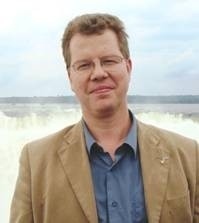
Beitrag von Prof. Dr. Johannes Orphal in der Zeitschrift "Wirtschaftswoche".
Zum Beitrag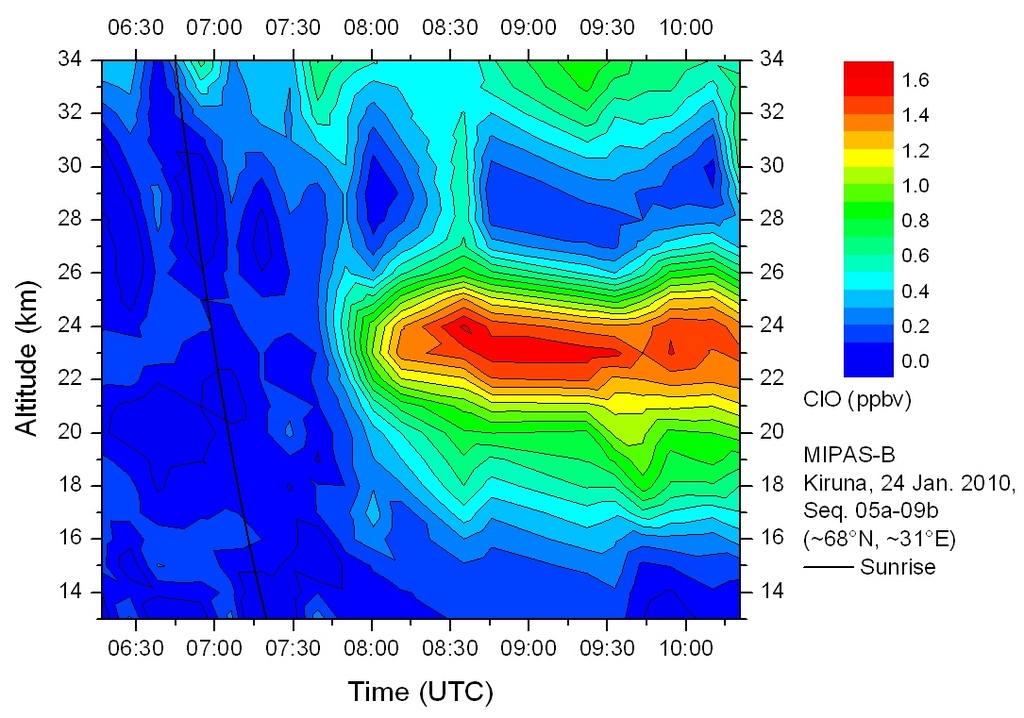
Mixing ratios of species like ClO, NO2, and N2O5, measured by the balloon-borne MIPAS instrument in January 2010 in the Arctic, show significant changes around sunrise which are temporally delayed due to polar stratospheric clouds reducing the direct radiative flux from the sun. ClO variations were derived the first time from MIPAS-B spectra. Results have been published recently in Atmospheric Chemistry and Physics by scientists from three institutes at KIT.
More information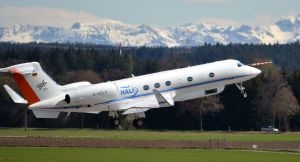
GLORIA Measures Highly Resolved Distributions of Atmospheric Trace Gases on Board of the New HALO Research Aircraft
To the press release
Interview mit Prof. Dr. Johannes Orphal in der Zeitschrift „Focus“
Zum Interview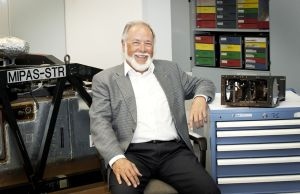
Hohe Auszeichnung für den KIT-Wissenschaftler: Das internationale Committee on Space Research (COSPAR) verleiht dem früheren Leiter des Instituts für Meteorologie und Klimaforschung (IMK) des KIT, Professor Herbert Fischer, die William Nordberg Medal 2012. Damit würdigt COSPAR Fischers herausragende Leistungen in der Atmosphärenforschung. Er gilt weltweit als einer der Pioniere der Fourier-Transformations-Infrarot-Spektrometrie, mit der sich die Konzentration von Spurengasen in der Atmosphäre bestimmen lässt, die unter anderem Auswirkungen auf den Treibhauseffekt haben. Fischer ist der erste deutsche Wissenschaftler, der die Medaille erhält.
Zur Pressemitteilung
Interview with Prof. Dr. Johannes Orphal in the journal "Wirtschaftswoche"
to the german interview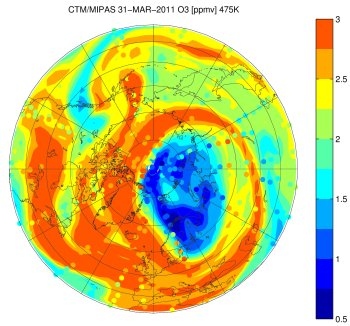
Unusually cold stratospheric temperatures lead to record large Arctic ozone loss during Winter 2010/2011. The detailed mechanisms leading to the formation of this first Arctic ozone hole have now been published in Geophysical Research Letters by a team of scientists from the KIT Institute for Meteorologie and Climate Research (IMK).
To the KIT Press Release
More information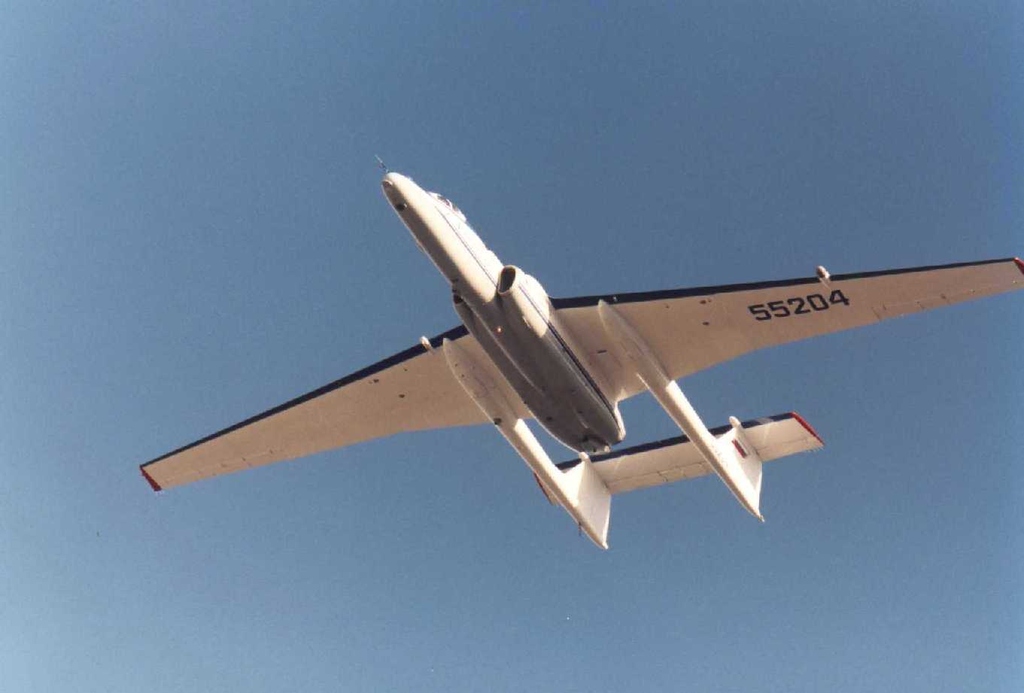
Präzise Messungen der Atmosphäre sind für Vorhersagen des Klimawandels und seiner Folgen, wie sie zurzeit auf der Weltklimakonferenz in Durban diskutiert werden, unentbehrlich. Eine Forschergruppe aus Jülich und Karlsruhe startet daher am 6. Dezember in Nordschweden ein einzigartiges Experiment: Das Instrument GLORIA fliegt erstmals mit dem russischen Forschungsflugzeug „Geophysica“ und beobachtet klimarelevante Gase und atmosphärische Bewegungen mit bisher unerreichter Genauigkeit. Diese Messungen tragen zu wesentlich verbesserten Klimamodellen bei.
Presseinformation des KIT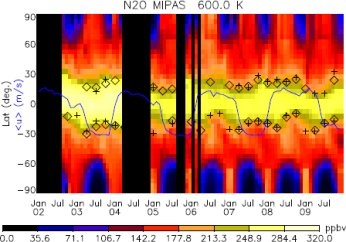
The subtropical transport barrier restricts air exchange between the tropical and the mid-latitudinal stratosphere.
More information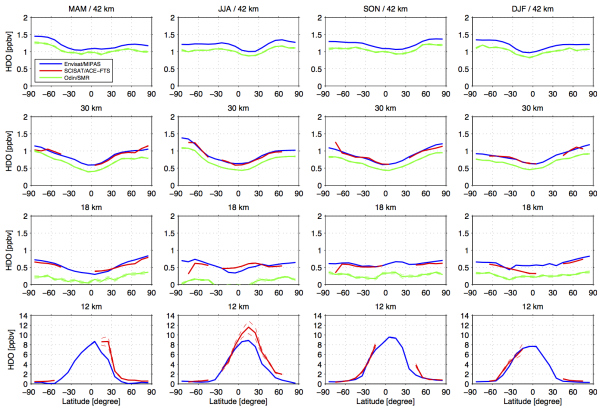
HDO from observations by Envisat/MIPAS, Odin/SMR, and SCISAT/ACE-FTS has been compared for all seasons and different altitudes.
More information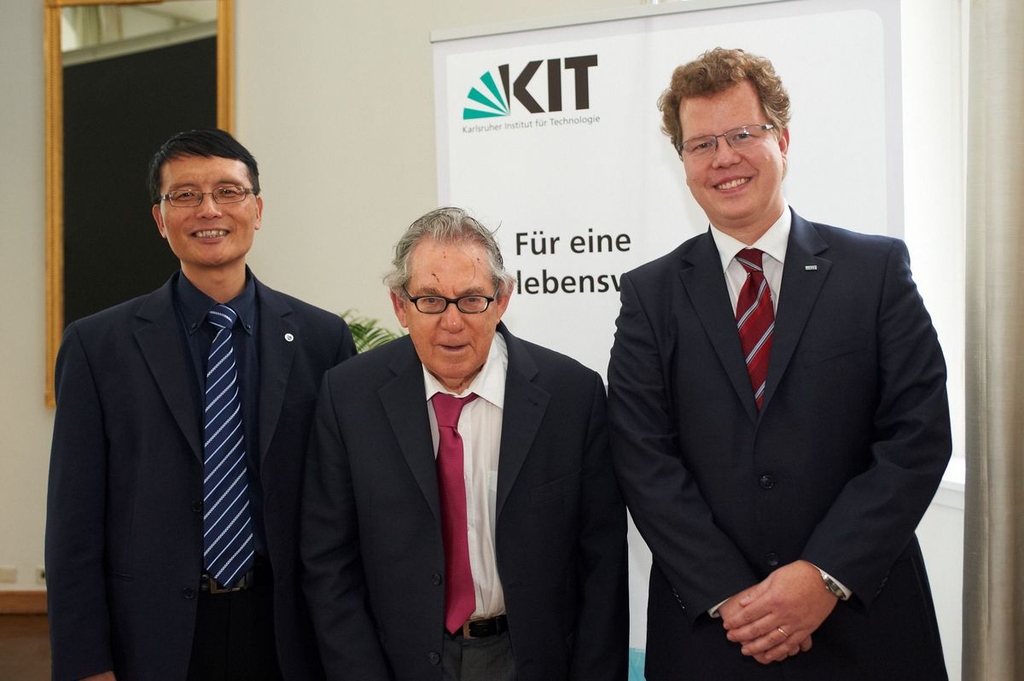
Auftakt zur neuen Veranstaltungsreihe: Rund 140 Zuhörer kamen am 18. Oktober zur ersten KIT Climate Lecture in den Gartensaal des Karlsruher Schlosses.
Mehr Informationen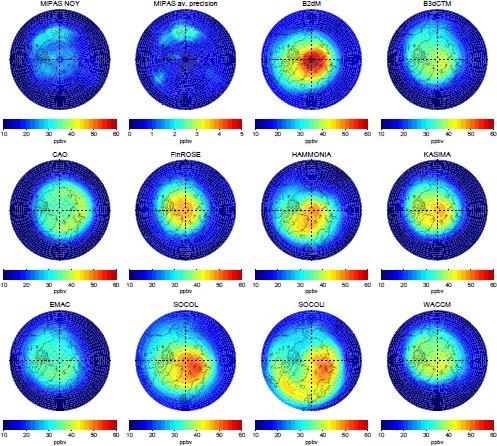
Results of a cooperative effort of the international community interested in the effects of "High Energetic Particle Precipitation in the Atmosphere" (HEPPA) on the chemistry of the middle atmosphere during the 2003 "Halloween" solar proton event have been published recently.
More information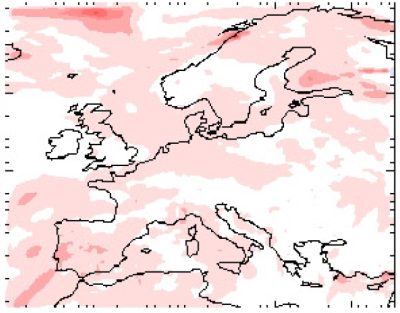
To answer this question IMK collaborates with Météo France.
More information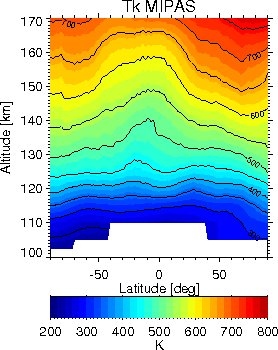
MIPAS provides first global day- and nighttime temperature and NO measurements in the thermosphere
More information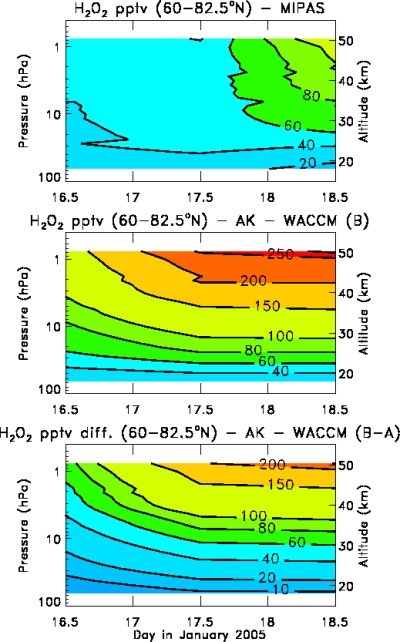
MIPAS observations of H2O2 during the Solar Proton Event in January 2005 indicate deficiencies in HOx modeling.
More information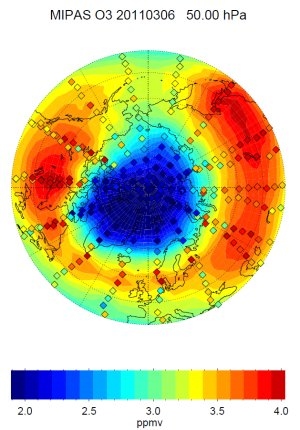
Atmosphärenwissenschaftler einer Forschergruppe der Deutschen Forschungsgemeinschaft (DFG) haben bei ihrem Jahrestreffen Ende Mai am KIT die neuesten Entwicklungen der stratosphärischen Ozonschicht diskutiert.
Zur Pressemitteilung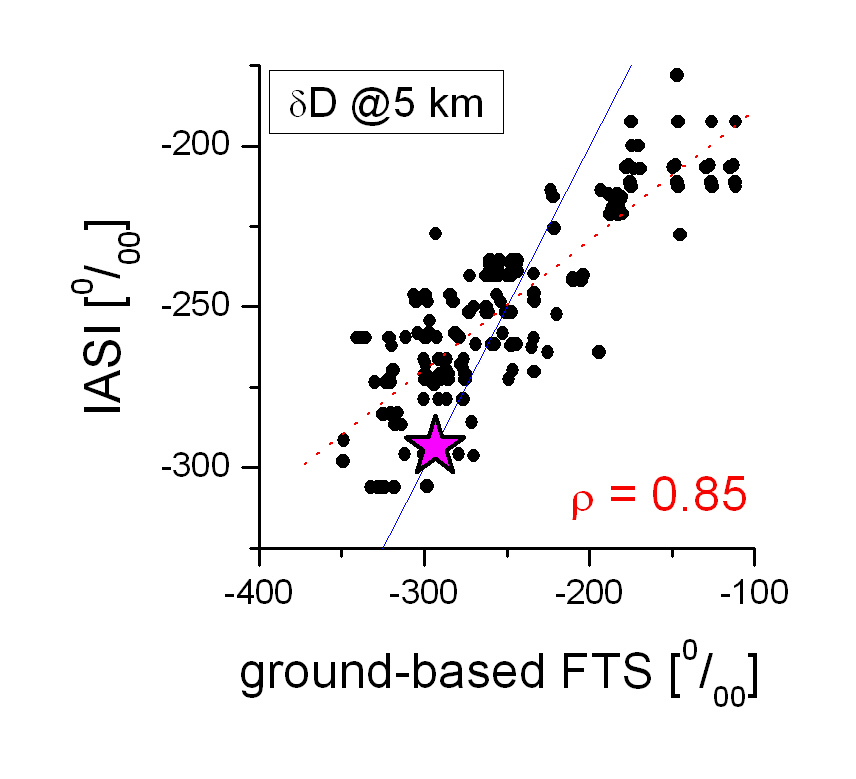
The first tropospheric HDO/H2O measurements applying an operational meteorological satellite instrument (IASI on METOP) have been reported. The new dataset is expected to reduce uncertainties in atmospheric water cycle modeling.
More information on the MUSICA website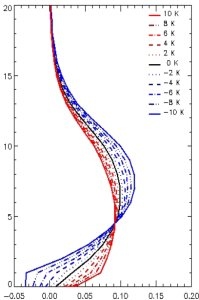
The IMK-ASF investigates the ability for air quality measurements of a projected thermal infrared (TIR) nadir sounder in a geostationary orbit.
More information
Scientists of the Karlsruhe Institute for Technology (KIT) has observed a record stratospheric polar ozone loss over the Arctic.
More information
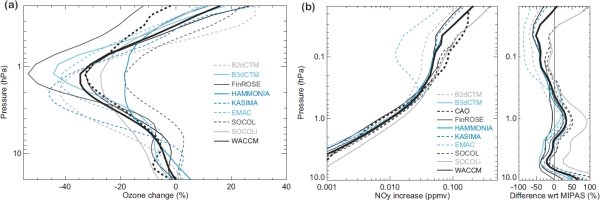
Within the SPARC-related initiative HEPPA (High Energetic Particle Precipitation in the Atmosphere), IMK-IAA-generated MIPAS data are used to assess the effect of solar proton events (SPE) on atmospheric chemistry.
More information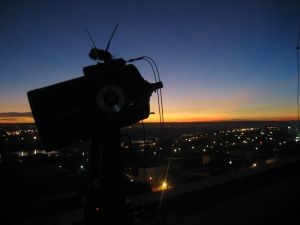
Zuschlag für eine Emmy-Noether-Nachwuchsgruppe der DFG für Forschungsprojekt am KIT.
Zur Pressemitteilung
Der Leiter des IMK – ASF am KIT gehört künftig dem wissenschaftlichen Beratungsausschuss des Europäischen Zentrums für mittelfristige Wettervorhersage an.
Zur Pressemitteilung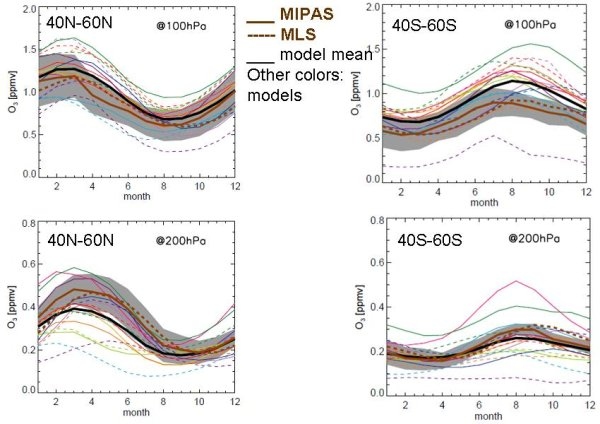
MIPAS observations of ozone in the mid-latitude upper troposphere / lower stratosphere region has been used to validate chemistry-climate models.
More information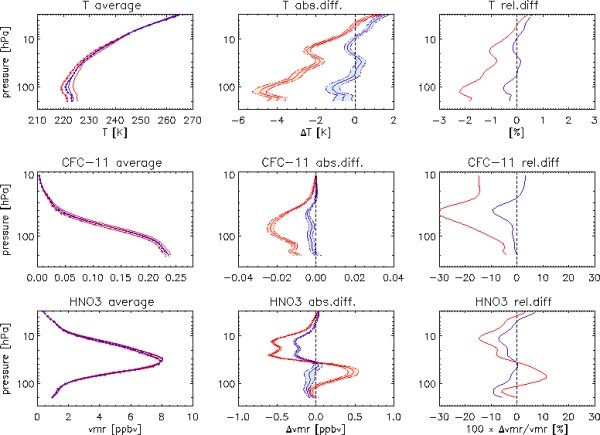
Including the temperature gradient the retrievals for temperature, CFC-11, and HNO3 significantly improve.
More information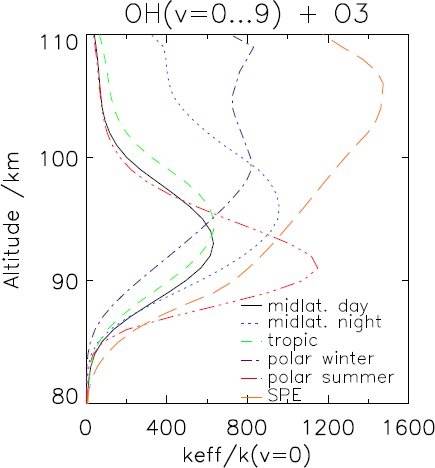
Above 80 km the vibrational states of OH are populated much more than under thermodynamic equilibrium conditions.
More information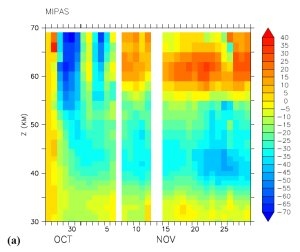
High energetic solar protons from solar flares and coronal mass ejections affect the chemical composition of the Earth's atmosphere in the stratospheric and mesospheric altitude regions by ionization, formation of NOx and HOx, and, subsequently, ozone destruction.
More information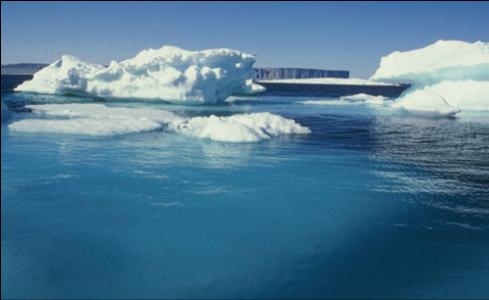
Professor Dr Johannes Orphal, Director of the Institute for Meteorology and Climate Research at KIT, calls for greater European efforts to tackle environmental changes…
pdf copy of the article in the journal "Science and Technology".
External link to the journal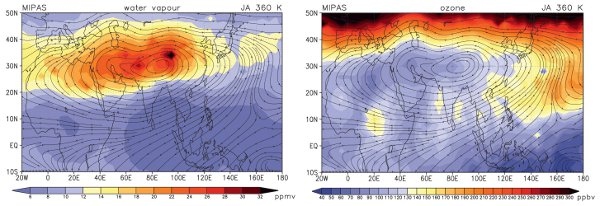
has been investigated with MIPAS-Envisat data for the first time.
More information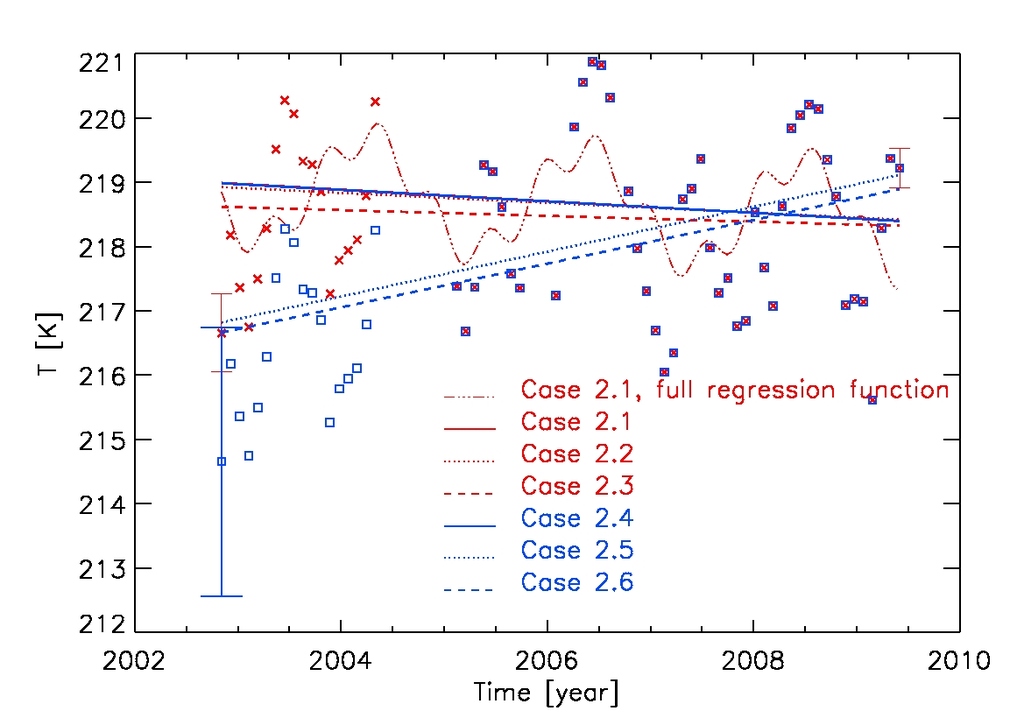
Long data sets as needed in climate research without any inhomogeneities are sparse. Thus, a method to deal with data inhomogeneities has been developed at IMK.
More information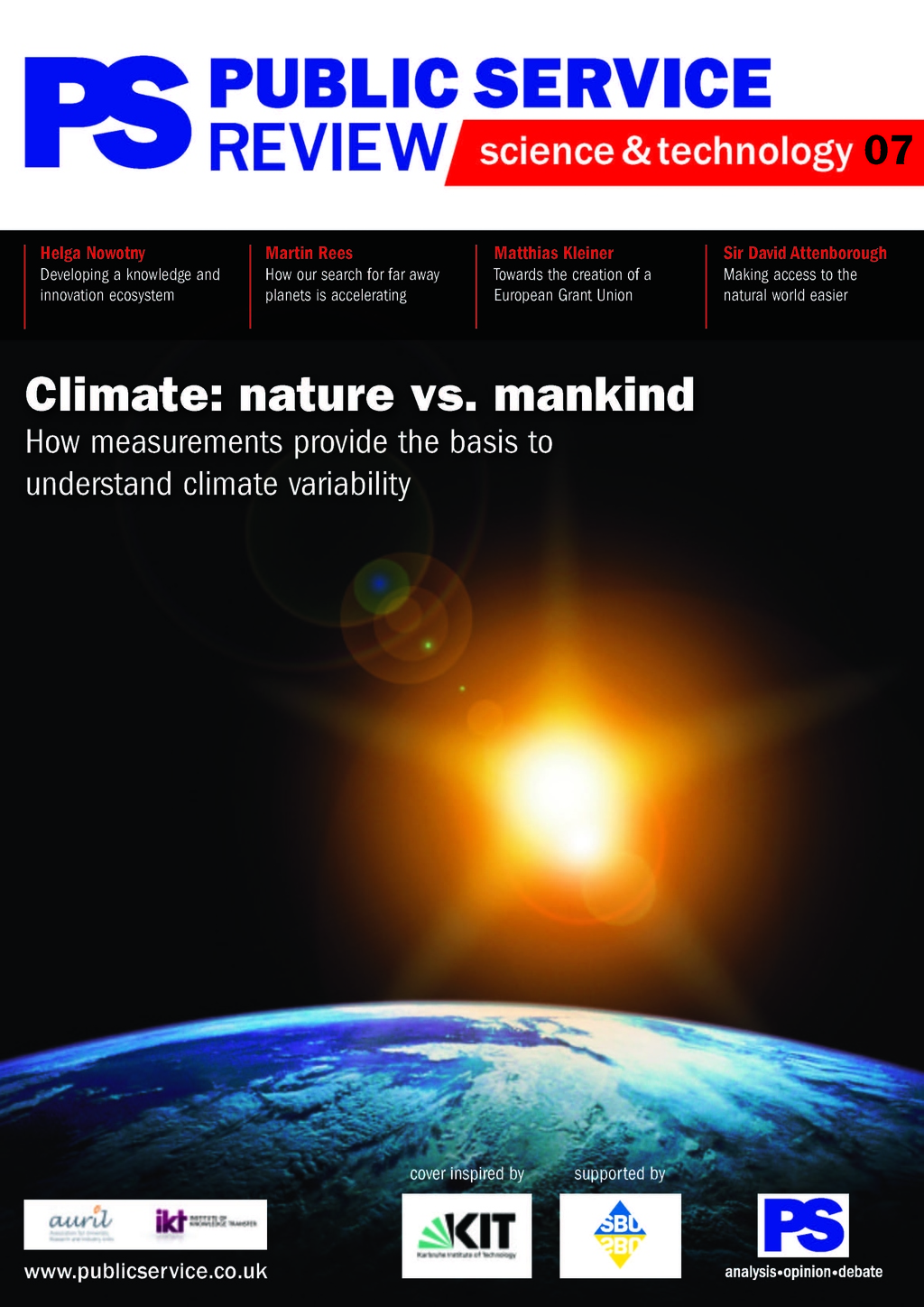
How measurements provide the basis to understand climate variability.
Pdf copy of the article in the journal "Public Service Review".
External link to the journal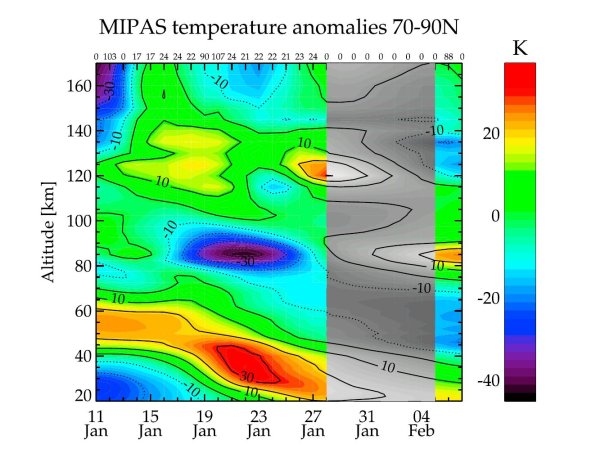
MIPAS provides first observational evidence of the coupling from the lower atmosphere to the thermosphere during a major stratospheric warming.
More information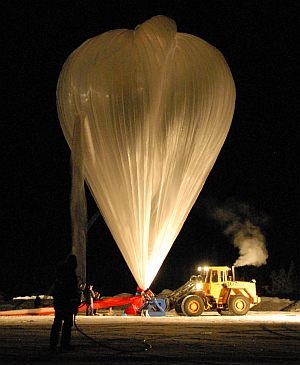
KIT Scientists Disprove Doubts in Ozone Hole Chemistry.
To Press Release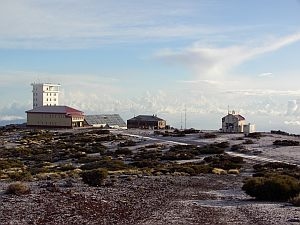
KIT-Wissenschaftler gewinnt Starting Independent Researcher Grant des Europäischen Forschungsrates.
Zur Pressemitteilung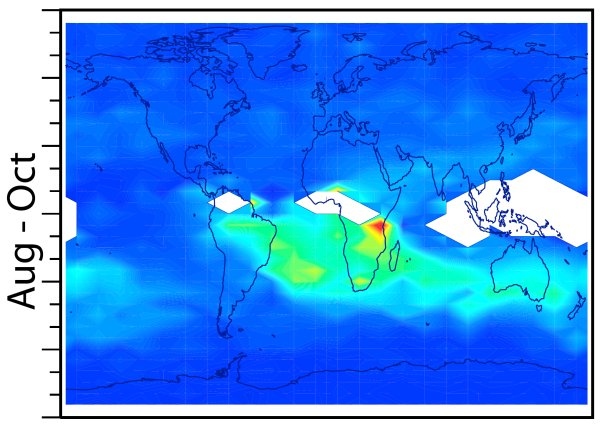
Enhanced mixing ratios are found in the downwind regions of biomass fires in South America and Africa.
More information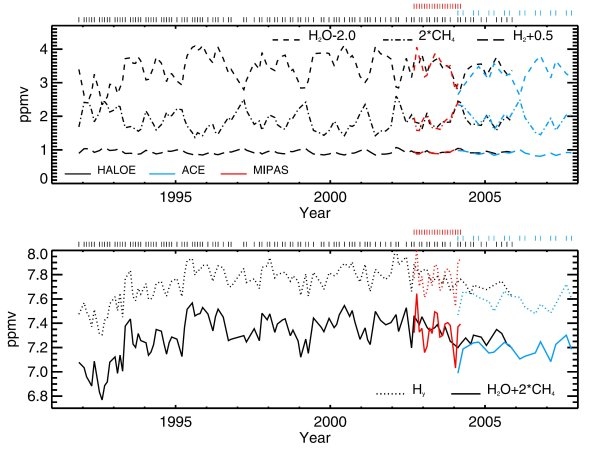
Oxidation of hydrogen contributes by ~ 0.4 ppm to the water vapour budget in the equatorial upper stratosphere
More information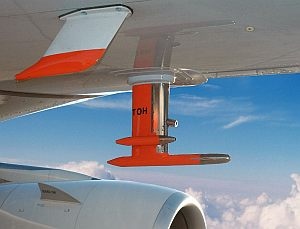
Am 20.04.2010 startete das Forschungslabor CARIBIC (Bild) einen Messflug auf einem modifizierten Passagierflugzeug (Airbus A340-600) von Lufthansa. Ziel ist die Vermessung der isländischen Vulkanaschewolke im Luftraum zwischen Frankfurt und Skandinavien in Höhen von 3 bis 8 km. CARIBIC ist ein Konsortium aus zwölf Forschungsinstitutionen aus sechs europäischen Ländern. Das Institut für Meteorologie und Klimaforschung (IMK) am KIT betreibt fünf der fünfzehn eingebauten Messinstrumente. Insgesamt werden ca. 100 Spurengase und Eigenschaften von Aerosolpartikeln gemessen. Die Wissenschaftler erhoffen sich bei dem Messflug genauere Informationen über die Höhenverteilung und der Partikelzusammensetzung der isländischen Vulkanaschewolke. Mehr Informationen zum CARIBIC-Projekt.
Zur Pressemitteilung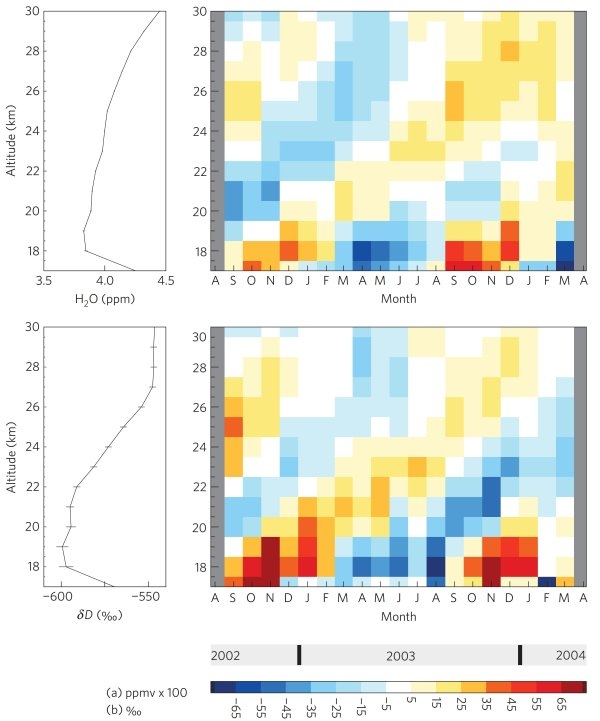
provide constraints on the role of convection for dehydration processes near the tropical tropopause
More informationThe upcoming meeting of the German French project will be held at Wednesday, March 17, 2010, at Karlsruhe Institute of Technologie (KIT).
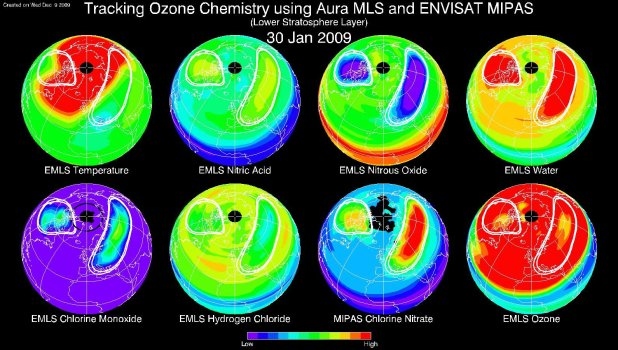
as seen by MLS/Aura and MIPAS/Envisat.
More information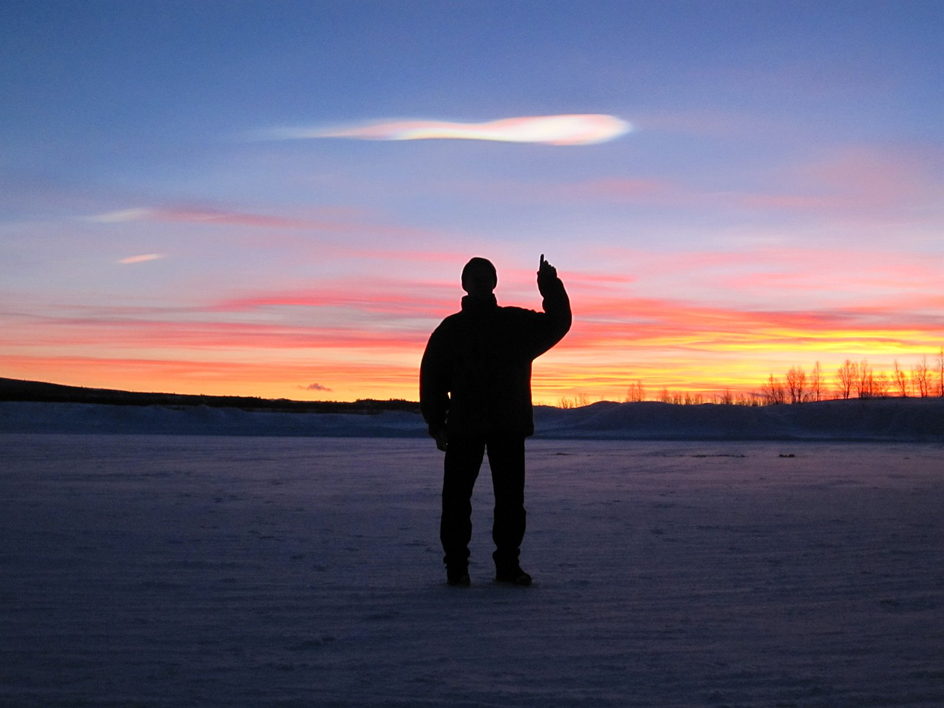
Embedded in the RECONCILE campaign the aircraft version of MIPAS has participated in all 8 flights of the Russian research aircraft Geophysica that can approach altitudes of up to 20 km. The objective of the measurements is to improve model representations of key processes dominating chemistry, microphysics and dynamics of Arctic stratospheric ozone loss.
More information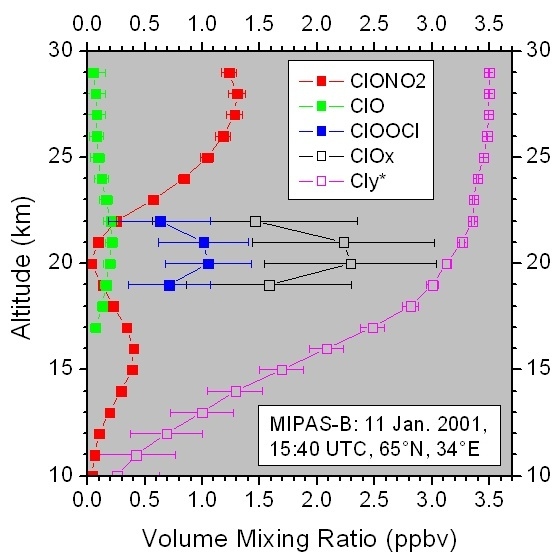
confirm the established polar chlorine chemistry, relevant for the springtime Arctic ozone destruction.
More information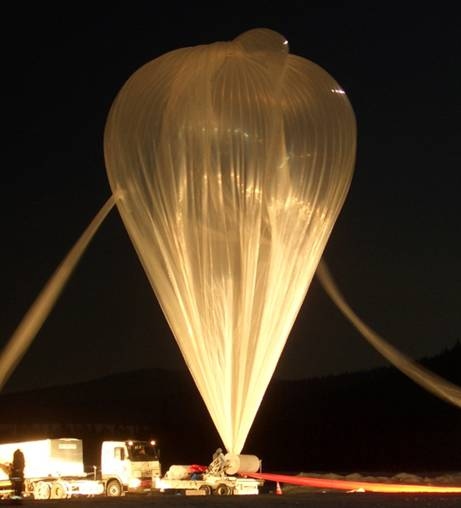
On 24.1.2010 at 1:46 the MIPAS/TELIS/mini-DOAS balloon payload was launched from Kiruna / Sweden to a 13 hrs flight into the core of the cold activated polar vortex to measure diurnal variations of chlorine and bromine species and for validating satellite measurements.
More information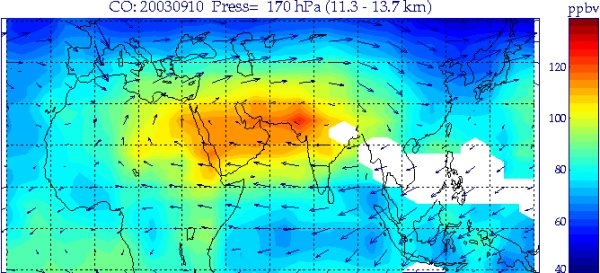
show that polluted air is trapped in the Asian monsoon anticyclone near the tropopause.
More information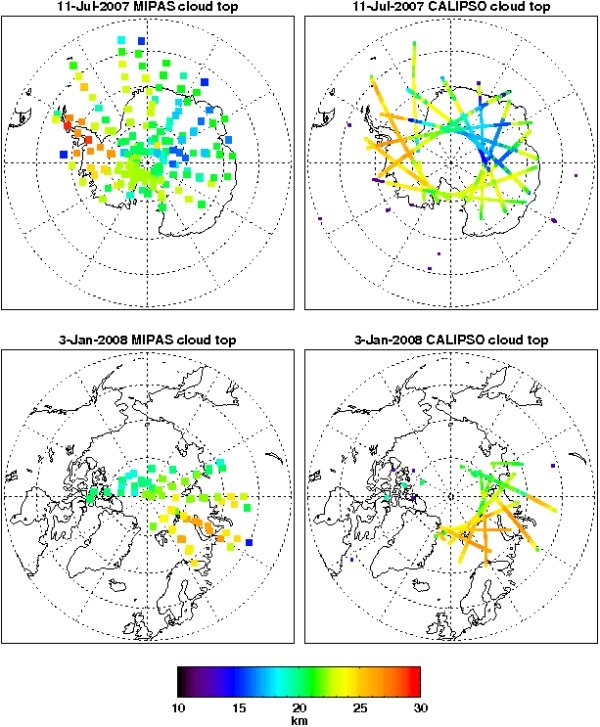
Comparisons of polar stratospheric cloud (PSC) observations between passive (MIPAS/Envisat) and active (CALIPSO) space-borne remote sensing instruments show a high degree of consistency.
More information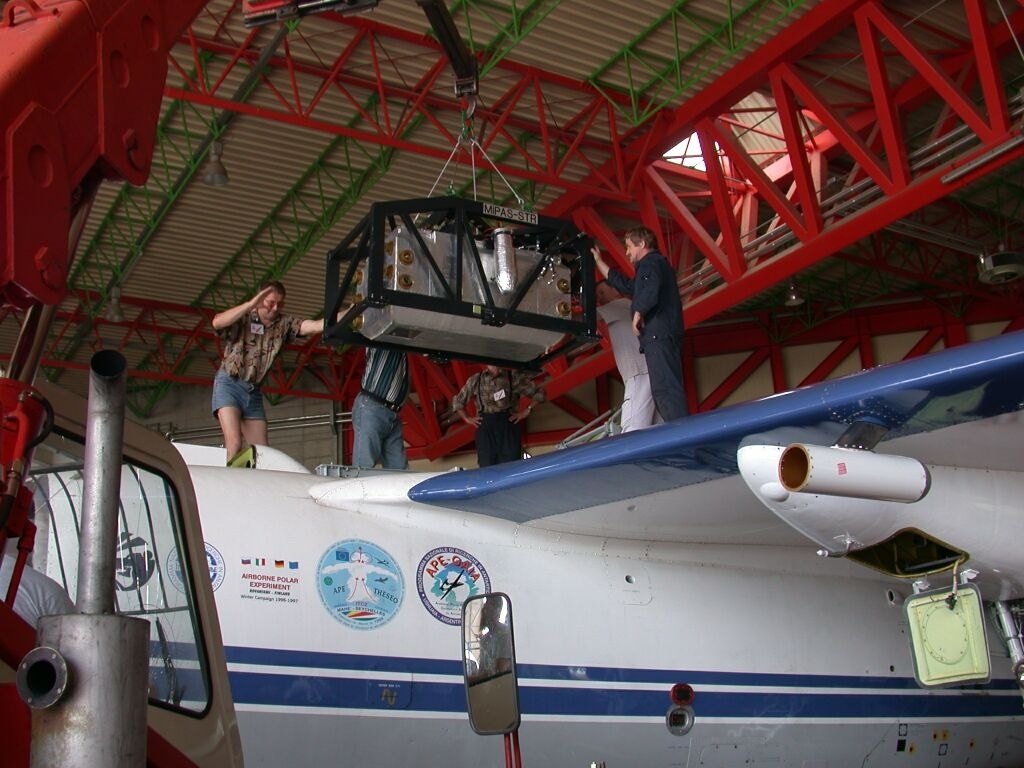
The MIPAS-STR instrument, a MIPAS version that is tailored to operation on the Russian high-flying (up to 21 km) Geophysica aircraft is currently participating in an international test campaign. The aircraft is based in Oberpfaffenhofen/Germany from Oct. 26 to Nov. 3. The test camapaign is sort of a rehearsal for a large mission scheduled for early 2010 in the framework of the EU-funded project RECONCILE, that aims at a deeper understanding of chemistry-climate relationsships and more reliable predictions of future ozone.
More information on MIPAS-STR und Geophysica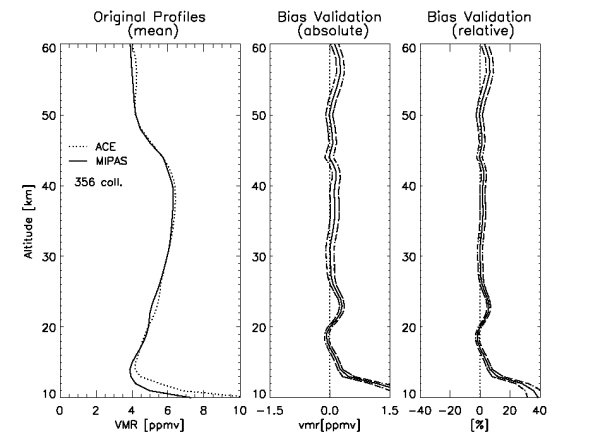
The MIPAS water vapour profiles retrieved at IMK (version 13) have been validated in an altitude range from 15-50 km by intercomparison with numerous independent in situ and remote measurements.
More information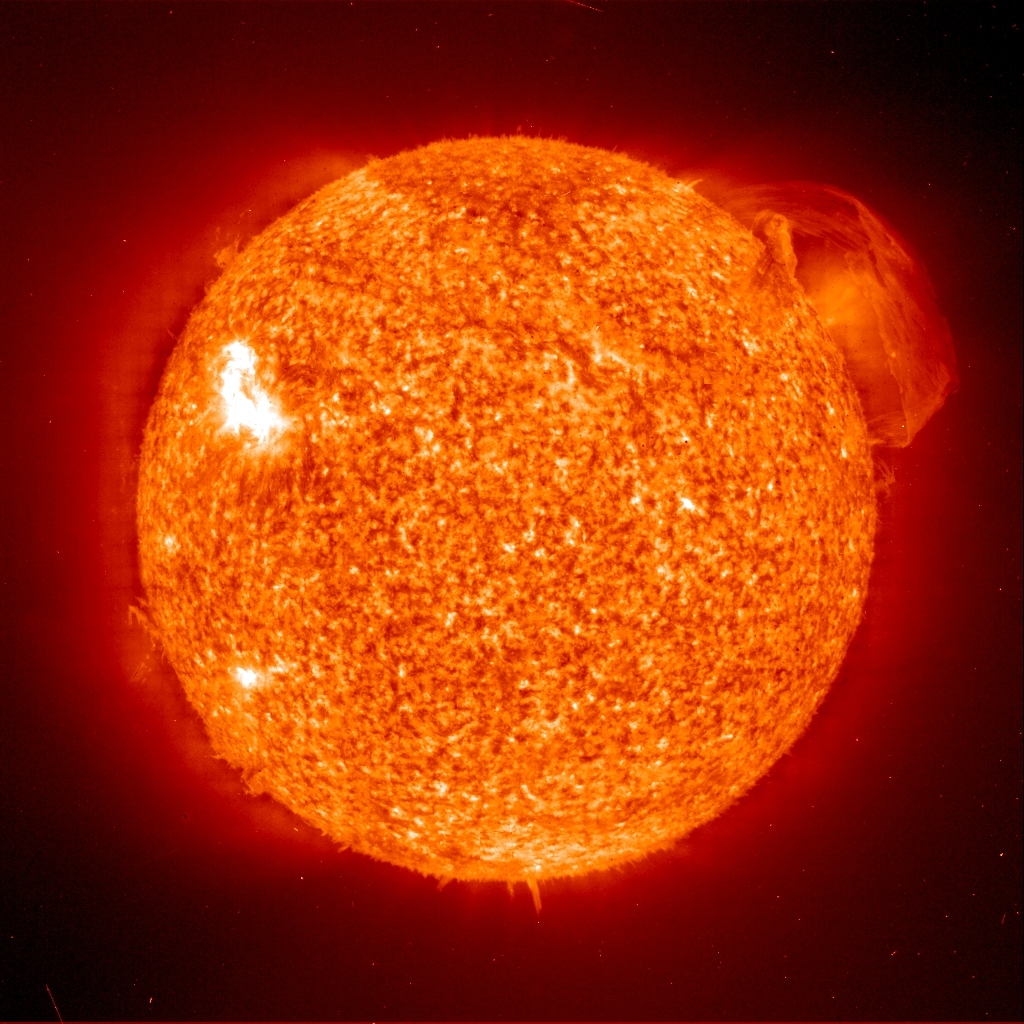
Dr. Miriam Sinnhuber and her group „Solar Variability, Climate, and the Role of the Mesosphere/Lower Thermosphere“ will investigate the influence of solar variablity on climate.
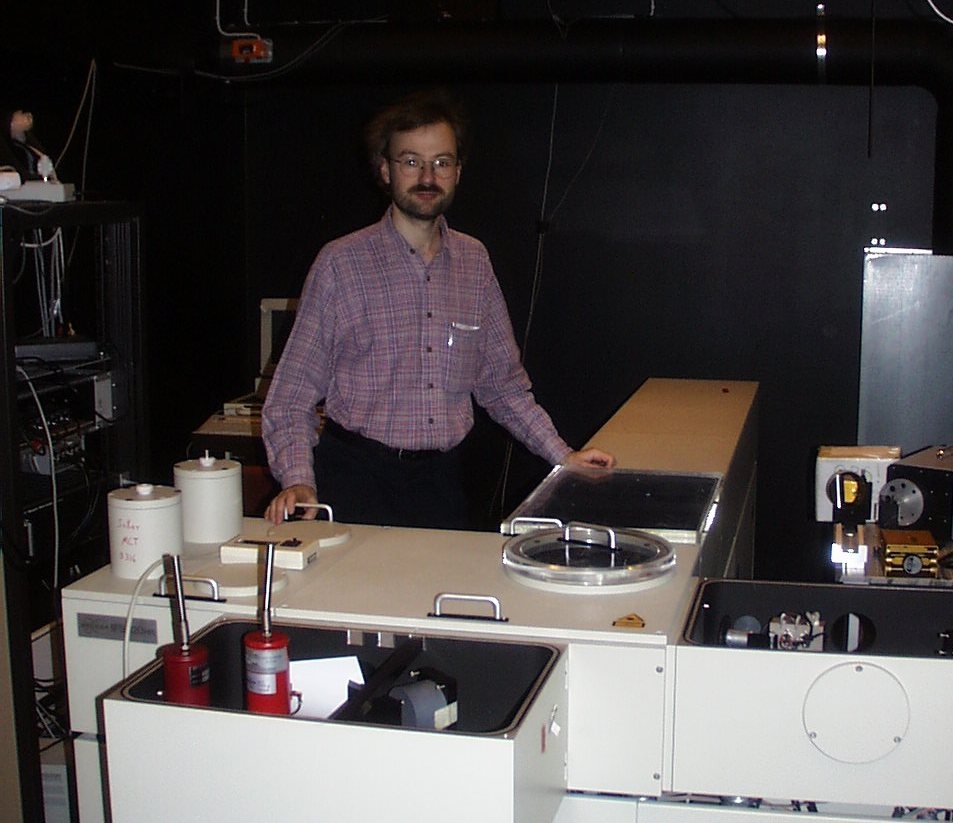
Scientists of the IMK-ASF validate new space-borne measurements of the tropospheric water vapour isotopy.
Link to the Article in the Science MagazineSince 1st of September 2009 the IMK-ASF website is published in a new design.

